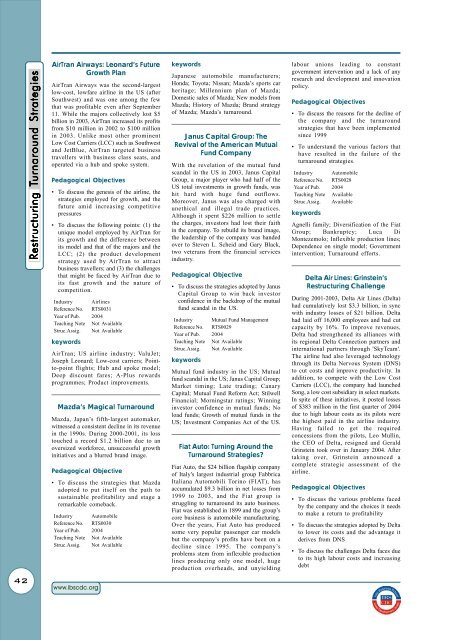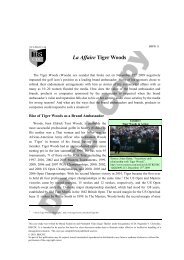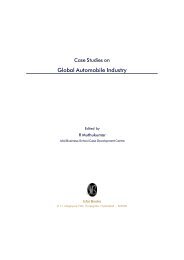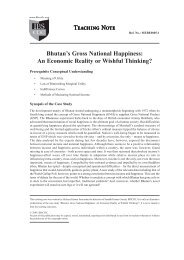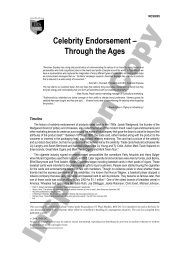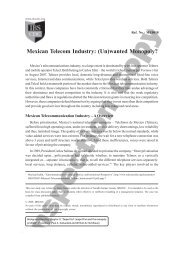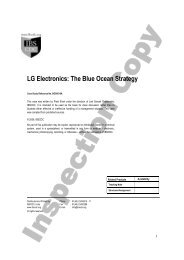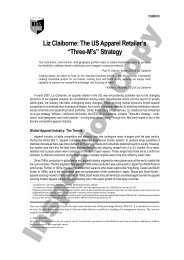List of Case Studies on Strategy - Case Catalogue IV
List of Case Studies on Strategy - Case Catalogue IV
List of Case Studies on Strategy - Case Catalogue IV
You also want an ePaper? Increase the reach of your titles
YUMPU automatically turns print PDFs into web optimized ePapers that Google loves.
42<br />
Restructuring estructuring T TTurnaround<br />
T urnaround Strategies<br />
Strategies<br />
AirTran Airways: Le<strong>on</strong>ard’s Future<br />
Growth Plan<br />
AirTran Airways was the sec<strong>on</strong>d-largest<br />
low-cost, lowfare airline in the US (after<br />
Southwest) and was <strong>on</strong>e am<strong>on</strong>g the few<br />
that was pr<str<strong>on</strong>g>of</str<strong>on</strong>g>itable even after September<br />
11. While the majors collectively lost $5<br />
billi<strong>on</strong> in 2003, AirTran increased its pr<str<strong>on</strong>g>of</str<strong>on</strong>g>its<br />
from $10 milli<strong>on</strong> in 2002 to $100 milli<strong>on</strong><br />
in 2003. Unlike most other prominent<br />
Low Cost Carriers (LCC) such as Southwest<br />
and JetBlue, AirTran targeted business<br />
travellers with business class seats, and<br />
operated via a hub and spoke system.<br />
Pedagogical Objectives<br />
• To discuss the genesis <str<strong>on</strong>g>of</str<strong>on</strong>g> the airline, the<br />
strategies employed for growth, and the<br />
future amid increasing competitive<br />
pressures<br />
• To discuss the following points: (1) the<br />
unique model employed by AirTran for<br />
its growth and the difference between<br />
its model and that <str<strong>on</strong>g>of</str<strong>on</strong>g> the majors and the<br />
LCC; (2) the product development<br />
strategy used by AirTran to attract<br />
business travellers; and (3) the challenges<br />
that might be faced by AirTran due to<br />
its fast growth and the nature <str<strong>on</strong>g>of</str<strong>on</strong>g><br />
competiti<strong>on</strong>.<br />
Industry Airlines<br />
Reference No. RTS0031<br />
Year <str<strong>on</strong>g>of</str<strong>on</strong>g> Pub. 2004<br />
Teaching Note Not Available<br />
Struc.Assig. Not Available<br />
keywords<br />
AirTran; US airline industry; ValuJet;<br />
Joseph Le<strong>on</strong>ard; Low-cost carriers; Pointto-point<br />
flights; Hub and spoke model;<br />
Deep discount fares; A-Plus rewards<br />
programmes; Product improvements.<br />
Mazda’s Magical Turnaround<br />
Mazda, Japan’s fifth-largest automaker,<br />
witnessed a c<strong>on</strong>sistent decline in its revenue<br />
in the 1990s. During 2000-2001, its loss<br />
touched a record $1.2 billi<strong>on</strong> due to an<br />
oversized workforce, unsuccessful growth<br />
initiatives and a blurred brand image.<br />
Pedagogical Objective<br />
• To discuss the strategies that Mazda<br />
adopted to put itself <strong>on</strong> the path to<br />
sustainable pr<str<strong>on</strong>g>of</str<strong>on</strong>g>itability and stage a<br />
remarkable comeback.<br />
Industry Automobile<br />
Reference No. RTS0030<br />
Year <str<strong>on</strong>g>of</str<strong>on</strong>g> Pub. 2004<br />
Teaching Note Not Available<br />
Struc.Assig. Not Available<br />
www.ibscdc.org<br />
keywords<br />
Japanese automobile manufacturers;<br />
H<strong>on</strong>da; Toyota; Nissan; Mazda’s sports car<br />
heritage; Millennium plan <str<strong>on</strong>g>of</str<strong>on</strong>g> Mazda;<br />
Domestic sales <str<strong>on</strong>g>of</str<strong>on</strong>g> Mazda; New models from<br />
Mazda; History <str<strong>on</strong>g>of</str<strong>on</strong>g> Mazda; Brand strategy<br />
<str<strong>on</strong>g>of</str<strong>on</strong>g> Mazda; Mazda’s turnaround.<br />
Janus Capital Group: The<br />
Revival <str<strong>on</strong>g>of</str<strong>on</strong>g> the American Mutual<br />
Fund Company<br />
With the revelati<strong>on</strong> <str<strong>on</strong>g>of</str<strong>on</strong>g> the mutual fund<br />
scandal in the US in 2003, Janus Capital<br />
Group, a major player who had half <str<strong>on</strong>g>of</str<strong>on</strong>g> the<br />
US total investments in growth funds, was<br />
hit hard with huge fund outflows.<br />
Moreover, Janus was also charged with<br />
unethical and illegal trade practices.<br />
Although it spent $226 milli<strong>on</strong> to settle<br />
the charges, investors had lost their faith<br />
in the company. To rebuild its brand image,<br />
the leadership <str<strong>on</strong>g>of</str<strong>on</strong>g> the company was handed<br />
over to Steven L. Scheid and Gary Black,<br />
two veterans from the financial services<br />
industry.<br />
Pedagogical Objective<br />
• To discuss the strategies adopted by Janus<br />
Capital Group to win back investor<br />
c<strong>on</strong>fidence in the backdrop <str<strong>on</strong>g>of</str<strong>on</strong>g> the mutual<br />
fund scandal in the US.<br />
Industry Mutual Fund Management<br />
Reference No. RTS0029<br />
Year <str<strong>on</strong>g>of</str<strong>on</strong>g> Pub. 2004<br />
Teaching Note Not Available<br />
Struc.Assig. Not Available<br />
keywords<br />
Mutual fund industry in the US; Mutual<br />
fund scandal in the US; Janus Capital Group;<br />
Market timing; Late trading; Canary<br />
Capital; Mutual Fund Reform Act; Stilwell<br />
Financial; Morningstar ratings; Winning<br />
investor c<strong>on</strong>fidence in mutual funds; No<br />
load funds; Growth <str<strong>on</strong>g>of</str<strong>on</strong>g> mutual funds in the<br />
US; Investment Companies Act <str<strong>on</strong>g>of</str<strong>on</strong>g> the US.<br />
Fiat Auto: Turning Around the<br />
Turnaround Strategies?<br />
Fiat Auto, the $24 billi<strong>on</strong> flagship company<br />
<str<strong>on</strong>g>of</str<strong>on</strong>g> Italy's largest industrial group Fabbrica<br />
Italiana Automobili Torino (FIAT), has<br />
accumulated $9.3 billi<strong>on</strong> in net losses from<br />
1999 to 2003, and the Fiat group is<br />
struggling to turnaround its auto business.<br />
Fiat was established in 1899 and the group’s<br />
core business is automobile manufacturing.<br />
Over the years, Fiat Auto has produced<br />
some very popular passenger car models<br />
but the company’s pr<str<strong>on</strong>g>of</str<strong>on</strong>g>its have been <strong>on</strong> a<br />
decline since 1995. The company’s<br />
problems stem from inflexible producti<strong>on</strong><br />
lines producing <strong>on</strong>ly <strong>on</strong>e model, huge<br />
producti<strong>on</strong> overheads, and unyielding<br />
labour uni<strong>on</strong>s leading to c<strong>on</strong>stant<br />
government interventi<strong>on</strong> and a lack <str<strong>on</strong>g>of</str<strong>on</strong>g> any<br />
research and development and innovati<strong>on</strong><br />
policy.<br />
Pedagogical Objectives<br />
• To discuss the reas<strong>on</strong>s for the decline <str<strong>on</strong>g>of</str<strong>on</strong>g><br />
the company and the turnaround<br />
strategies that have been implemented<br />
since 1999<br />
• To understand the various factors that<br />
have resulted in the failure <str<strong>on</strong>g>of</str<strong>on</strong>g> the<br />
turnaround strategies.<br />
Industry Automobile<br />
Reference No. RTS0028<br />
Year <str<strong>on</strong>g>of</str<strong>on</strong>g> Pub. 2004<br />
Teaching Note Available<br />
Struc.Assig. Available<br />
keywords<br />
Agnelli family; Diversificati<strong>on</strong> <str<strong>on</strong>g>of</str<strong>on</strong>g> the Fiat<br />
Group; Bankruptcy; Luca Di<br />
M<strong>on</strong>tezemolo; Inflexible producti<strong>on</strong> lines;<br />
Dependence <strong>on</strong> single model; Government<br />
interventi<strong>on</strong>; Turnaround efforts.<br />
Delta Air Lines: Grinstein’s<br />
Restructuring Challenge<br />
During 2001-2003, Delta Air Lines (Delta)<br />
had cumulatively lost $3.3 billi<strong>on</strong>, in sync<br />
with industry losses <str<strong>on</strong>g>of</str<strong>on</strong>g> $21 billi<strong>on</strong>. Delta<br />
had laid <str<strong>on</strong>g>of</str<strong>on</strong>g>f 16,000 employees and had cut<br />
capacity by 16%. To improve revenues,<br />
Delta had strengthened its alliances with<br />
its regi<strong>on</strong>al Delta C<strong>on</strong>necti<strong>on</strong> partners and<br />
internati<strong>on</strong>al partners through 'SkyTeam'.<br />
The airline had also leveraged technology<br />
through its Delta Nervous System (DNS)<br />
to cut costs and improve productivity. In<br />
additi<strong>on</strong>, to compete with the Low Cost<br />
Carriers (LCC), the company had launched<br />
S<strong>on</strong>g, a low cost subsidiary in select markets.<br />
In spite <str<strong>on</strong>g>of</str<strong>on</strong>g> these initiatives, it posted losses<br />
<str<strong>on</strong>g>of</str<strong>on</strong>g> $383 milli<strong>on</strong> in the first quarter <str<strong>on</strong>g>of</str<strong>on</strong>g> 2004<br />
due to high labour costs as its pilots were<br />
the highest paid in the airline industry.<br />
Having failed to get the required<br />
c<strong>on</strong>cessi<strong>on</strong>s from the pilots, Leo Mullin,<br />
the CEO <str<strong>on</strong>g>of</str<strong>on</strong>g> Delta, resigned and Gerald<br />
Grinstein took over in January 2004. After<br />
taking over, Grinstein announced a<br />
complete strategic assessment <str<strong>on</strong>g>of</str<strong>on</strong>g> the<br />
airline.<br />
Pedagogical Objectives<br />
• To discuss the various problems faced<br />
by the company and the choices it needs<br />
to make a return to pr<str<strong>on</strong>g>of</str<strong>on</strong>g>itability<br />
• To discuss the strategies adopted by Delta<br />
to lower its costs and the advantage it<br />
derives from DNS<br />
• To discuss the challenges Delta faces due<br />
to its high labour costs and increasing<br />
debt


